November 20, 2023
A Taste of Titan
Dragonfly Team Debuts Johns Hopkins APL’s Newest Environmental Test Chamber
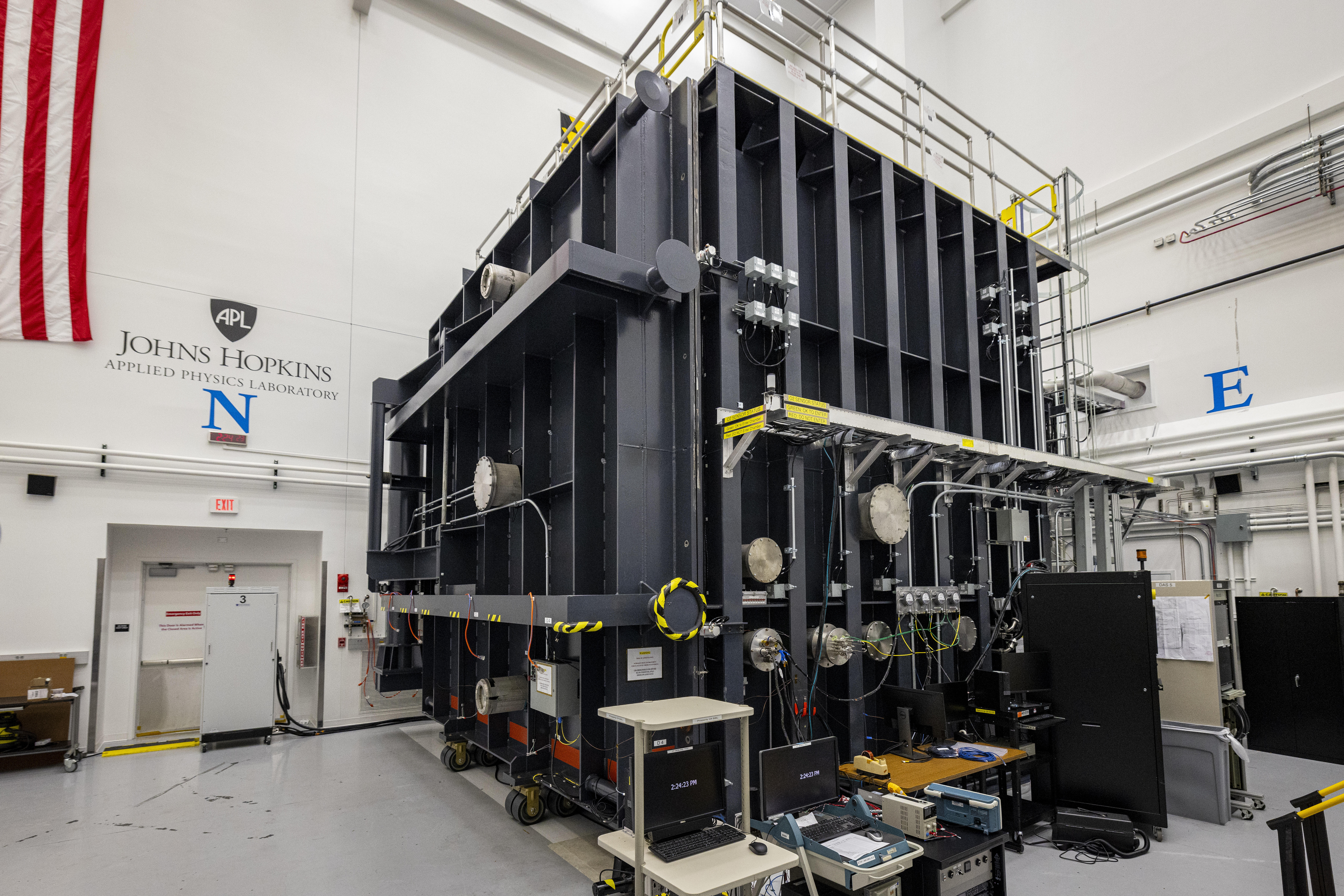
At 15 feet tall, wide and deep, the Titan Chamber is the largest environment simulator ever deployed at APL. (Credit: NASA/Johns Hopkins APL/Ed Whitman)
The Titan Chamber — the largest environmental simulator ever deployed on the campus of the Johns Hopkins Applied Physics Laboratory (APL) in Laurel, Maryland — is open for business.
The team developing NASA’s Dragonfly mission recently took the chamber for an opening run with a full-scale thermal model of its nuclear-powered car-sized drone, which it will send to Saturn’s moon Titan later this decade. In late October, while attached to a 12-by-12-foot platform inside the approximately 3,000-cubic-foot chamber, the model of the rotorcraft lander’s main structure endured the frigid temperatures and approached the atmospheric pressure of Titan’s methane-rich environment.
“The Dragonfly mission poses extreme engineering challenges,” said APL’s Diarny Fernandes, assembly lead of the Dragonfly thermal development test model. “We need to design a vehicle to operate in ambient temperatures of minus 180 degrees Celsius, in an atmosphere four times denser than Earth’s. We have smaller test chambers at APL that fully simulate the Titan environment, but we can only use them to evaluate the performance of components such as electronics boxes and mechanisms. Now, with the Titan Chamber, we can perform environmental testing at scale.”
Dragonfly, NASA’s only mission to the surface of another ocean world, is designed to investigate the complex chemistry that is the precursor to life. The vehicle, which APL is building and will operate, will be equipped with cameras, sensors and a sampling system to examine areas of Titan known to contain organic materials that may have previously come in contact with liquid water beneath the organic-rich, icy surface.
Inside the chamber, the team is using the Dragonfly thermal development test module — or DTM — to verify key thermal engineering factors for those flights across Titan. The checklist for those tests includes determining the best way to attach the insulating foam that will protect Dragonfly from the frigid Titan atmosphere, finding and reducing areas where heat might leak from the lander’s body, assessing thermal hardware performance including the trim devices used to adjust the lander’s internal temperature, and enhancing the computational fluid dynamics models used to predict temperatures and airflow on Titan’s surface.
Affixed with more than 200 temperature and airflow sensors, the DTM itself is an “impressive structure,” said Jane He, thermal lead for the Dragonfly rotorcraft lander at APL. The DTM took a year to design and build. It also replicates several features planned for the real Dragonfly, from its aluminum-honeycomb structure, to the 3D-printed housings for flight-electronics boxes, to the complex network of heaters and fans that simulate the thermal properties of Dragonfly’s power source (a multi-mission radioisotope thermoelectric generator) and the air-circulation system that will maintain the rotorcraft’s internal temperatures.
“The DTM is also covered in polystyrene foam that simulates the thermal properties of the insulation that will cover nearly every exposed surface on Dragonfly,” she added. “The engineering and test teams are covering every detail.”
The weeklong Dragonfly test ran around the clock and was fully successful. APL intends to use this facility quite a bit over the next several years to advance the maturity of the Dragonfly lander as well as for several other programs.
“Operation of the Titan Chamber is a significant milestone that advances our spaceflight development capability,” said Bobby Braun, head of APL’s Space Exploration Sector. “Created with internal investment funds, this facility is critical to making sure that a game-changing mission like Dragonfly is able to operate reliably in the exotic, alien environment of Titan. It also provides our teams with a cutting-edge resource to prepare a broad range of spacecraft for exploration of the extreme environments found in the outer solar system.”
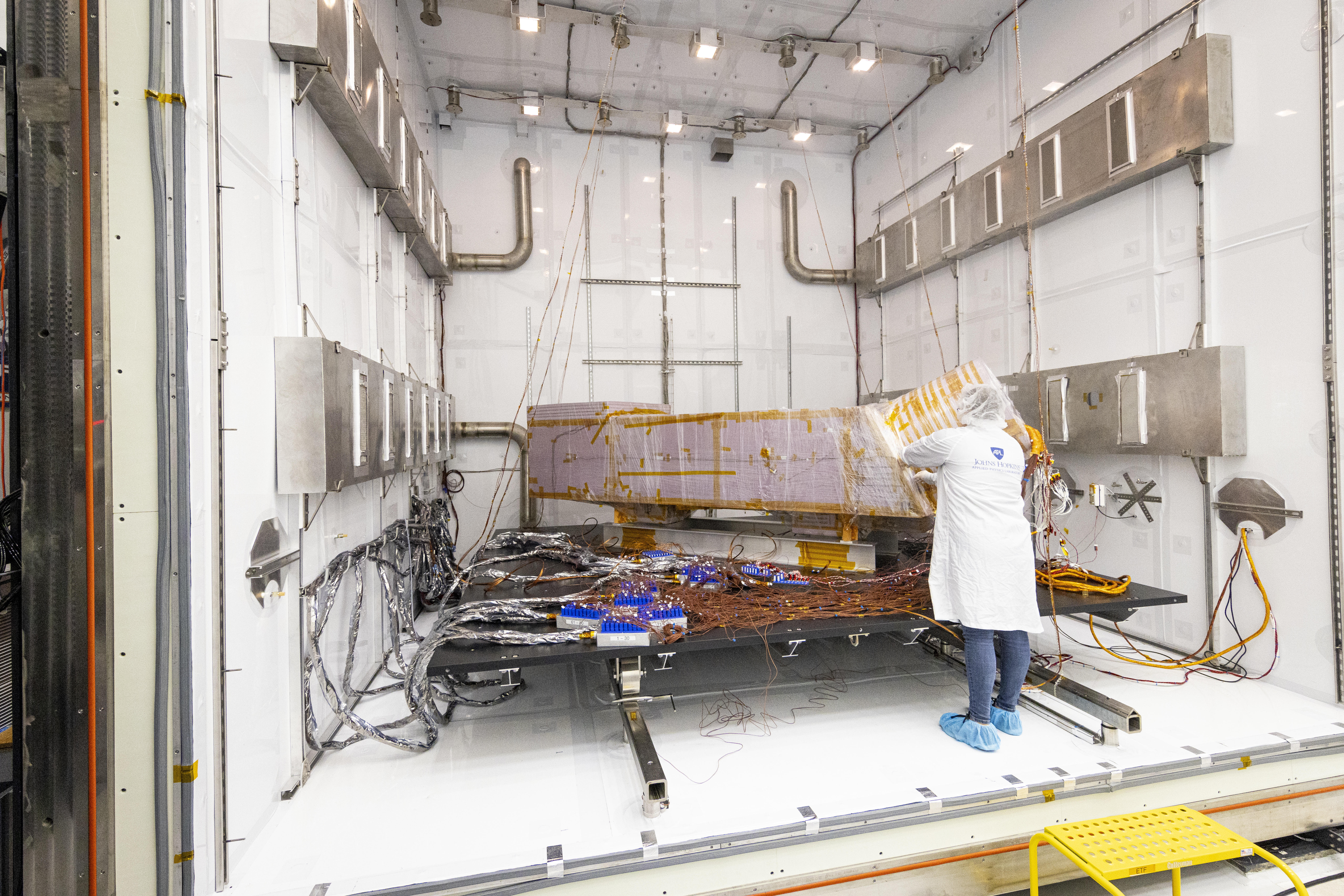
The Titan Chamber — APL’s largest environmental simulator — is open for business. The team developing NASA’s Dragonfly mission recently took the chamber for an opening run with a full-scale thermal model of the rotorcraft lander it will send to Saturn’s moon Titan later this decade. (Credit: NASA/Johns Hopkins APL/Ed Whitman)
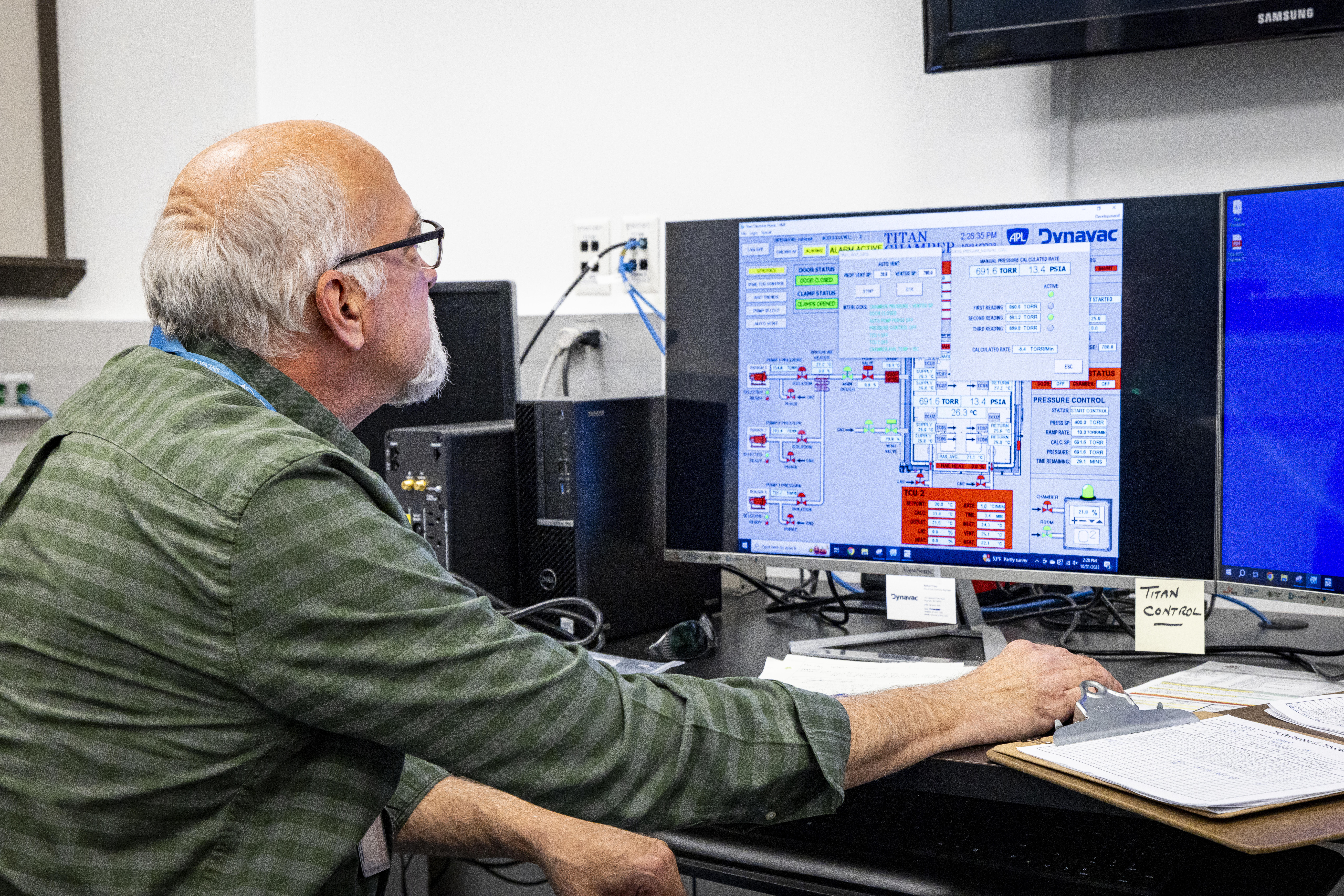
Engineer Andy Webb of APL checks conditions inside the Titan Chamber during its first tests. (Credit: NASA/Johns Hopkins APL/Ed Whitman)
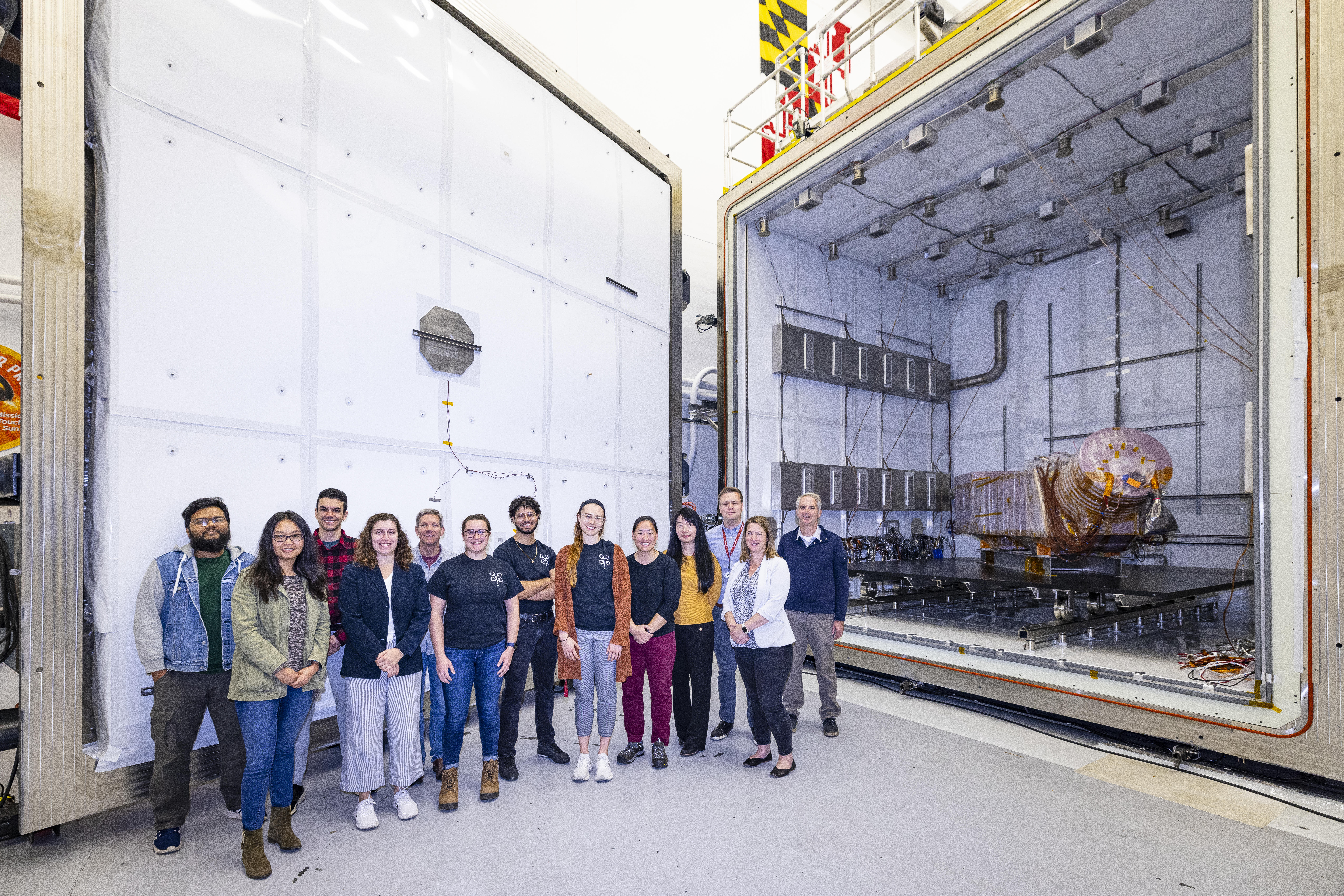
Dragonfly team members (from left) Ahmed Abir, Hui Liu, Jonathan D’Alessio, Marisa Teti, Bruce Williams, Ashley Lakey, Diarny Fernandes, Collette Gillaspie, Simmie Berman, Jane He, Kurt Gonter, Liz Abel and Dan Young gather in front of the Titan Chamber — with the Dragonfly thermal development test module (DTM) still inside — after successful completion of the chamber’s first tests. Not pictured are team members Dahway Lin, Emory Toomey, Shane Callahan and Tyler Radomsky. (Credit: NASA/Johns Hopkins APL/Ed Whitman)
Facts about the APL Titan Chamber
- It’s a large cube, approximately 15 feet on all sides.
- To simulate 24 continuous hours of Titan’s temperatures and atmospheric pressure, the chamber uses 200 gallons of liquid nitrogen per hour.
- The chamber’s motorized door opens (or closes) in 4 minutes and 30 seconds.
- Including insulation, the chamber weighs about 165,000 pounds.
- The chamber is made of 304L stainless steel with carbon steel stiffeners.
- The chamber’s 12-by-12-foot payload cart can accommodate 10,000 pounds.
- The chamber’s 12 ceiling-mounted hard points, for hanging or supporting payloads, can support 1,000 pounds each.
- After Dragonfly launches, APL will reconfigure the chamber from temperature-altitude testing to full thermal-vacuum testing.
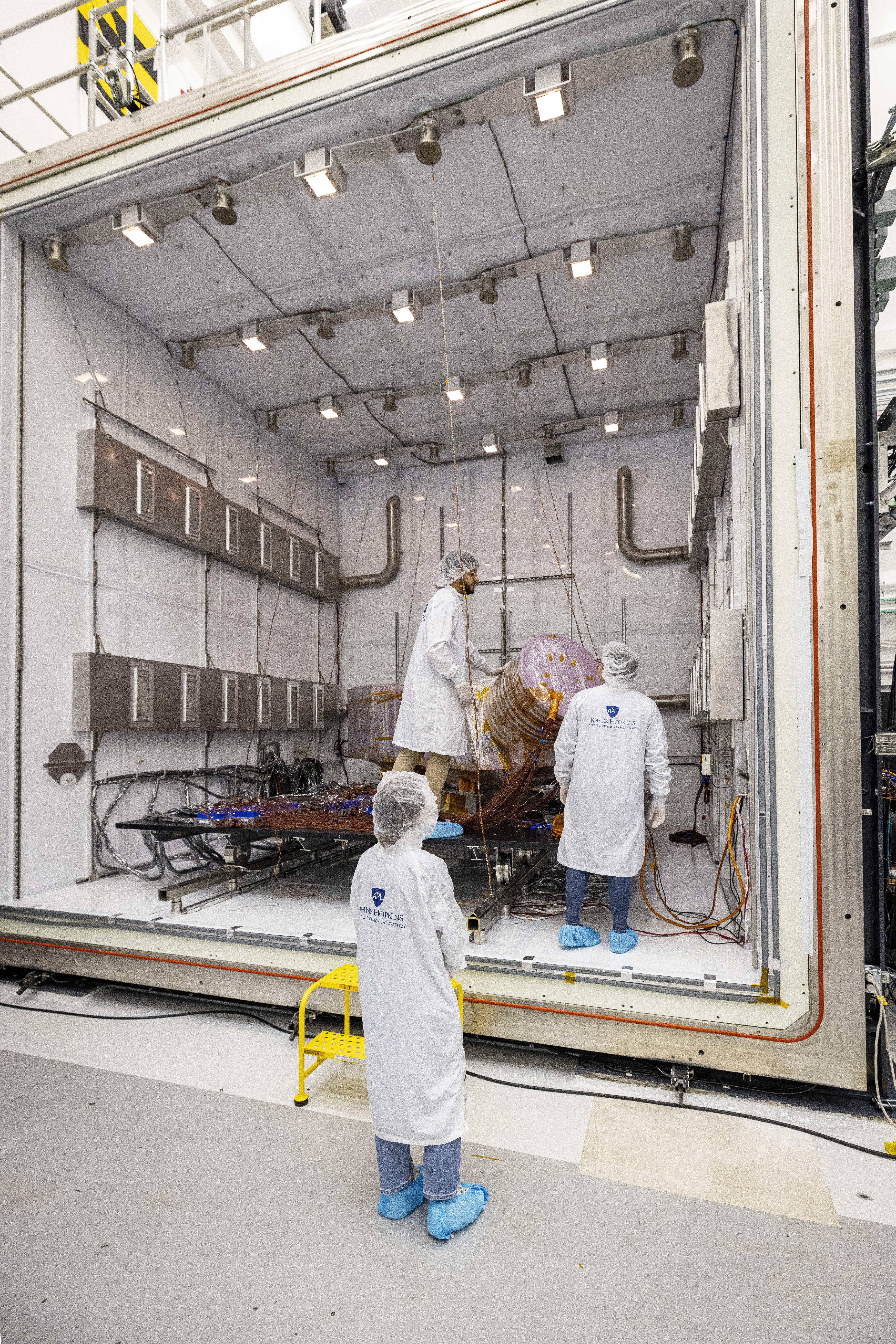
Dragonfly team members Diarny Fernandes, Ashley Lakey and Rachel Fox ready the Dragonfly thermal development test module (DTM) for temperature and atmospheric condition tests in the APL’s Titan Chamber. (Credit: NASA/Johns Hopkins APL/Ed Whitman)


